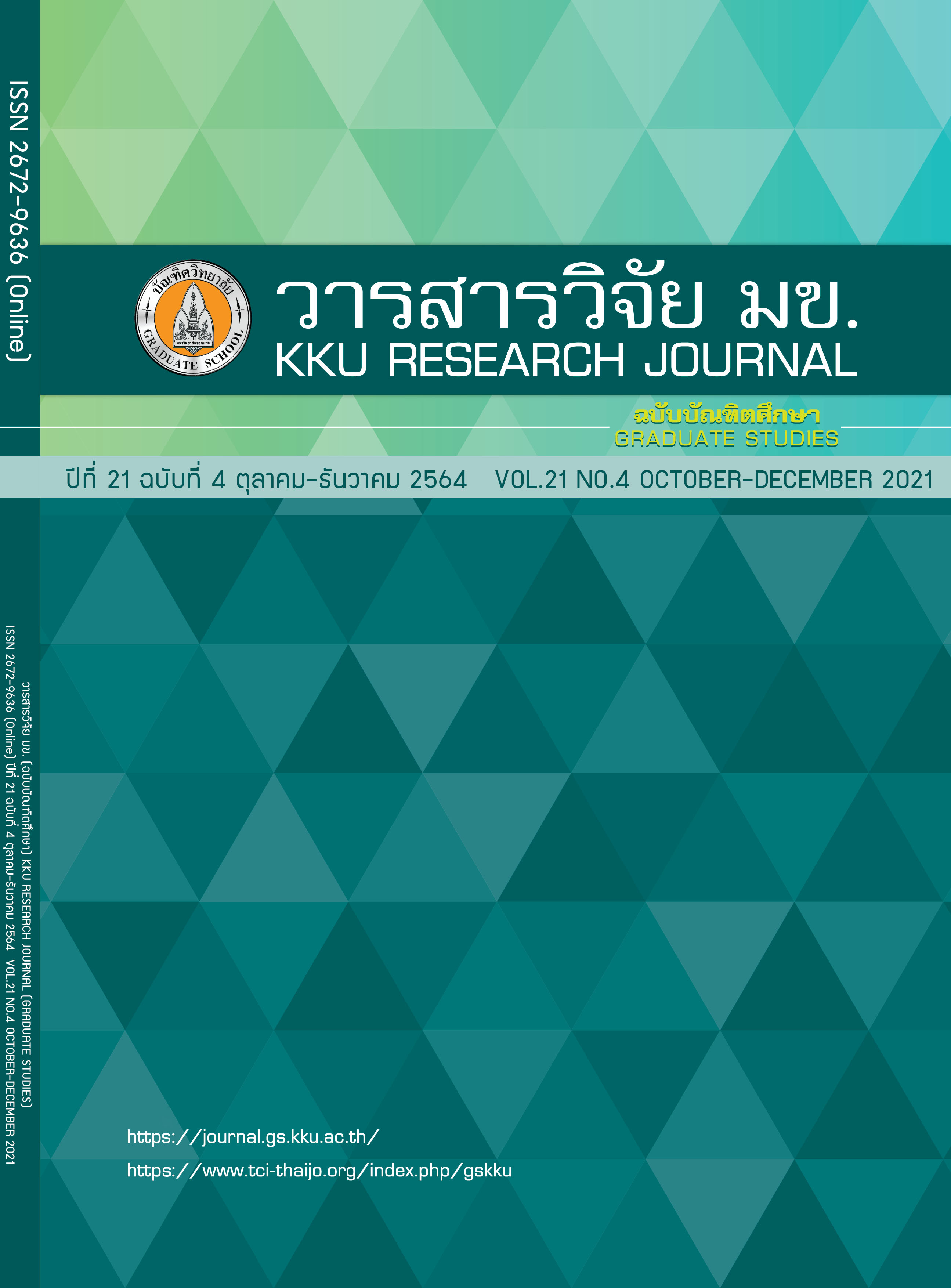Smart Early Childhood in The Northeast Region
Smart Early Childhood
Keywords:
Health literacy, Quality of life, Smart early childhoodAbstract
The objective of this research aimed to assess smart early childhood’s situation in northeast of Thailand and to analyze associations with variable of characteristics, health literacy, child rearing behavior, caregiver’s quality of life and smart early childhood in northeast region. Data collection was done by using a questionnaire to collect data from 584 caregivers and assessment development of early child (0-5 years) 584 samples by using Denver developmental screening test II. The data was analyzed by multiple logistic regressions. The result revealed that situation of smart early childhood in northeast region; normal developmental, appropriate growth and no decayed tooth 35.1%. Factors associated with smart early childhood when they are controlled with other influential factors; there are total 5 factors; 1) caregiver income (AOR = 2.1 95% CI = 1.38, 3.14, P value < 0.001) 2) age range of early childhood (AOR = 1.5 95% CI = 1.09, 2.07, P value < 0.040) 3) preterm labor (AOR = 2.0 95% CI = 1.29, 3.00, P value = 0.002) 4) health literacy of caregiver (AOR = 2.1 95% CI = 1.21, 4.15, P value = 0.046) and 5) quality of life about social relationship of the caregiver (AOR = 1.6 95% CI = 1.05, 2.29, P value < 0.029).
References
Walker SP, Wachs TD, Grantham MG, Black SM, Nelson CA, Huffman SL, et al. Inequality in Early Childhood: Risk and Protective Factors for Early Child Development. Elsevier Ltd all Rights Reserved. 2011; 378(9799): 1325-1338.
Nittaya K. Windows of Opportunity. [Internet]. 2014. [updated 2014 Feb 24; cited 2019 Feb 24]. Available from: http://thaichilddevelopment.com/new/2-3-58/. Thai.
World Health Organization. The Health Literacy Toolkit for Low- and Middle-Income Countries. A series of information sheet to help empower communities and strengthen health systems. Regional Office of South East Asia; 2015.
Bureau of Dental Health. National Oral Health Survey Report in Thailand 2017. [Internet]. 2018. [updated 2018 Jan 19; cited 2019 Feb 24]. Available from: http://dental2.anamai.moph.go.th/ewt_dl_link.php?nid=2423. Thai.
National Statistical Office. Economic and Social Condition Survey Throughout the Kingdom and the Census and Housing; 2017. Thai.
Bee H. The growing child. New York: Harper Collins College Publishers; 1995.
Lee SM, Federico S, Klass P, Abrams MA, Dreyer B. Literacy and Child Health A Systematic Review. Arch Pediatr Adolesc Med. 2009; 163(2): 131-140.
Strategy and Planning Division Office of the Permanent Secretary. Ministry of Public Health. Details of indicators, Ministry of Public Health Annual fiscal year; 2018. Thai.
National Statistical Organization. Thailand multiple Indicator cluster survey. In Bangkok: National Statistical Organization and UNICEF; 2012.
Hsieh YF, Bloch DA, Larsen MD. A simple method of sample size calculation for linear and logistic regression. Statistics in medicine. 1998; 17(14): 1623-1634.
Nutbeam D. The evolving concept of health literacy. Social Science &Medicine. 2008; 67(12): 2071-2078.
World Health Organization Quality of Life Questionnaire-BREF: Thai version (WHOQOL-BREF: THAI). Available from: http://www.dmh. moph.go.th/ test/whoqol/.
Department of Health, Ministry of Public Health. Development Situation and Behavior Survey for Early Childhood Behavior of Thai Families; 2017. Thai.
Department of Health, Ministry of Public Health (2014). Survey of health development and growth of early childhood years; 2014. Thai.
Ozkan M, Senel S, Arslan EA. The socioeconomic and biological risk factors for developmental delay in early childhood. Eur J Pediatrics. 2012; 171: 1815–1821. Available from: DOI 10.1007/ s00431-012-1826-1821.
Jintana P, Wanwisa K. The 6th Study of Factors Affecting the Development of Early Childhood in Thailand, 2017. Health Promotion Bureau, Department of Health, Ministry of Public Health; 2018. Thai.
Tharatip K, Chanthima J. Integration of Premature Infant Health Promotion System Nakhon Si Thammarat Province Knowledge management for developing maternal and infant health networks Maternal and Infant Health Network Project; 2016. Thai.
Lakshmanan A, Agni M, Lieu T, Fleegler E, Kipke M, Friedlich PS, et al. The impact of preterm birth <37 weeks on parents and families: a cross-sectional study in the 2 years after discharge from the neonatal intensive care unit. Health and Quality of Life Outcomes. 2017; 15 (1): 38. Available from: http://dx.doi.org/10.1186/s12955-017-0602-3.
Elizabeth M, Jessica YL, Darren AD, William F. Impact of Caregiver Literacy on Children’s Oral Health Outcomes. Pediatrics. 2010; 126(1): 107 – 114. Available from: www.pediatrics.org/cgi/doi/10.1542/ peds. 2009-2887.
Yamada A, Kato M, Suzuki M, Tanaka S, Watanabe N, Akechi T, et al. Quality of life of parents raising children with pervasive developmental disorders. BMC Psychiatry Journals. 2012; 12: 119. Available from: http://www. biomedcentral.com /1471-244X/12/119.



